Panasonic Lumix DMC-GH2 Review
Panasonic Lumix DMC-GH2
Panasonic's 16 megapixel GH2 may look like a DSLR but in fact it's the latest compact system alternative. Could it possibly be the best Micro Four Thirds camera we've seen?
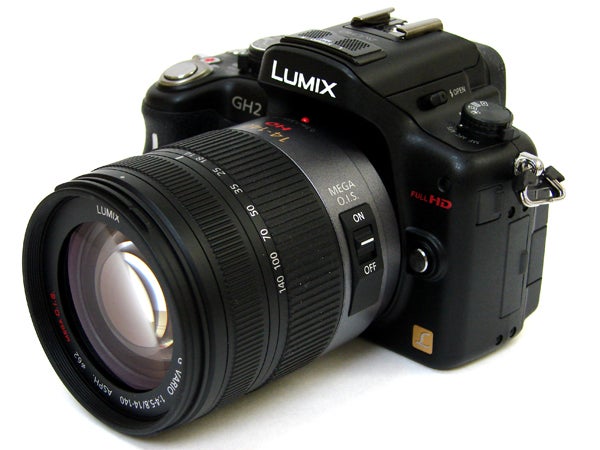
Verdict
Pros
- Hugely Versatile
- One-touch HD Video recording
- Articulated touchScreen
- Fast performance
- Close to SLR image quality
Cons
- Slightly cramped feel
- Expensive
- Slightly fiddly touchscreen interface
- Image quality not quite up to a DSLR
Key Specifications
- Review Price: £760.00
- 16.5-megapixel sensor
- Micro Four Thirds interchangeable lenses
- One-touch HD video recording
- Full manual controls
- Articulated touchscreen
The Panasonic Lumix DMC-GH2 updates the highly acclaimed if rather pricey GH1 Micro Four Thirds system camera, released about 18 months ago. As such the GH2’s styling is closer to that of a baby DSLR than its sibling’s, the GF2 compact camera form. While stylistically similar, its size is roughly a third of the size of Olympus’ Four Thirds E-5 DSLR, and closer in fact to that of a bridge camera. Except unlike a bridge camera, the Panasonic’s added appeal is the ability to swap the lens in use. Therefore it’s fair to say that for those who like the feel of a DSLR but not the attendant bulk, the GH2 is potentially a very attractive proposition. It’s in effect a DSLR ‘lite’.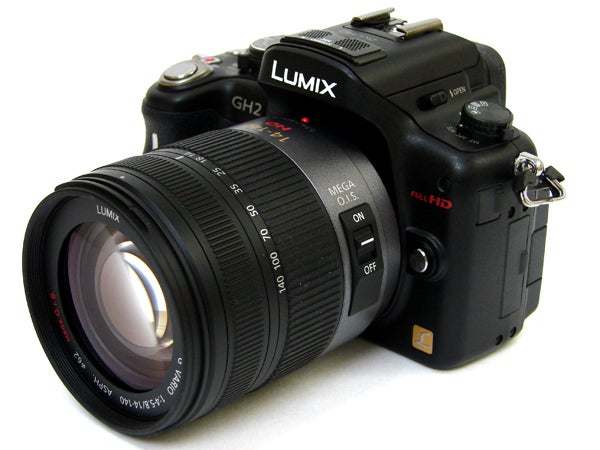
Like the rest of Panasonic’s G series, the GH2 goes up against not just actual DSLRs from Canon, Nikon, Pentax and the rest, but also compact system cameras such as Olympus’ new E-PL2, the Sony NEX-3, NEX-5 and its translucent mirrored SLT-A55 and A33 models, plus the Samsung NX100, NX10 and NX11. All are viable alternatives, so what makes Panasonic’s GH2 particularly appealing?
Well, for starters there’s the highest resolution currently offered by a Micro Four Thirds camera, here a whopping 16.05 (effective) megapixels from a newly developed 18.31 megapixel Live Mos sensor, even if it is physically smaller than the APS-C sized chips favoured by most digital SLRs. This, in terms of the numbers at least, places the GH2 up there with ‘proper’ DSLRs, while being much smaller, lighter and easier to handle. Like the latest crop of SLRs, the Panasonic aims to ensnare the amateur ‘movie’ maker here via Full HD movie capture with stereo sound plus its newly added ‘Cinema’ Film mode promising richer tonal gradation. HDMI output lets you hook up straight to a TV while a dedicated top plate record button provides one-touch access to video, no matter which alternative mode has been selected on the top plate shooting dial. Furthermore, manually selectable light sensitivity settings are expansive, reaching from ISO160 all the way up to ISO12800 equivalent for (theoretically at least) shooting without flash in the near dark, thanks in part says Panasonic to the inclusion of a latest generation Venus Engine FHD processor.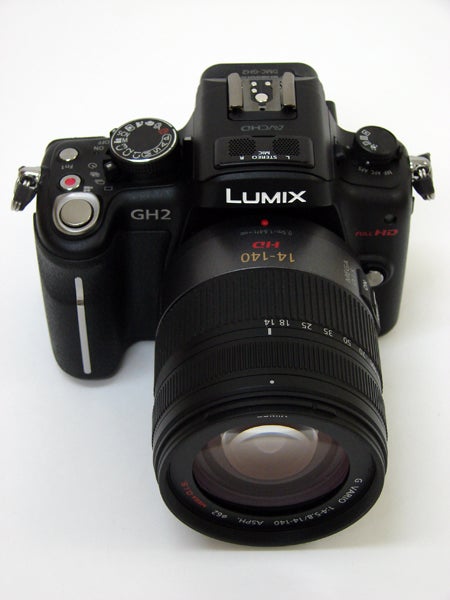
Panasonic supplied our review unit as the kit which includes a 14-140mm f/4-5.8 zoom, the extremely versatile equivalent of a 28-280mm lens in 35mm film terms. The suggested manufacturer’s list price for this combo is a sizeable £1299.99, putting it on a par with semi-pro DSLRs such as the 60D and D7000. More affordable but obviously less creatively flexible is the alternative kit comprising camera and 14-42mm standard zoom at £899.99, or there’s a body-only option at £799.99. The best deal we could find online at the time of writing was £760 with the 14-42mm lens, which is a good starter option.
Additionally, and as with the equally new DMC-GF2, if you choose to attach Panasonic’s new H-FT012 lens costing around £250, 3D MPO files can also be generated, though only viewed with the aid of a suitably enabled TV. Like shooting Raw and JPEG, MPO and JPEG can handily be shot in tandem if a more readily viewable back up is required. Any extended writing time is hardly noticeable due to the JPEGs being fairly low res. 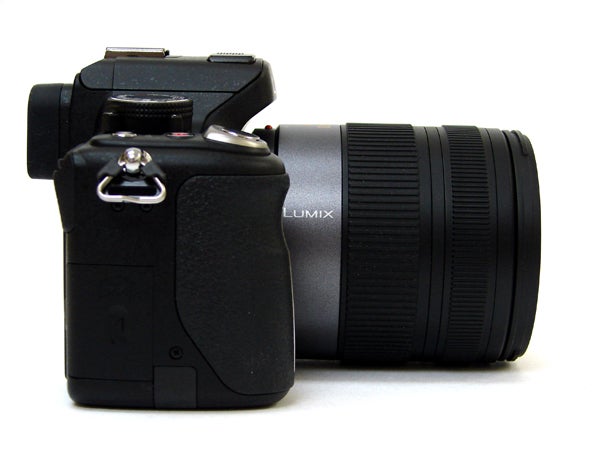
Whilst this might not in itself tip your purchase decision one way or the other, it’s a nice option to have, especially if looking to generate self-made 3D content and wanting a good quality camera and lens with which to do it. Further new optics introduced alongside the GH2 include the image stabilised 100-300mm telephoto zoom – a mouth watering option which Panasonic also furnished us with for our test shots – retailing at a penny shy of £600, plus, for anyone searching for the most compact Micro Four Thirds set up, the company’s compatible 14mm pancake lens for around £349. With five camera bodies and 11 Lumix lenses in play at the time of writing, there are growing options to extend creativity, budget allowing. The impression given is that here is a camera system on the up, that has a whole lot more potential ahead. So what of the design, layout, handling and performance of the camera itself? Read on to find out…
A sophisticated matt black finish and a fairly busy control layout with plenty to twist prod and push disguises the amount of plastic in the build, which manages the trick of feeling at once lightweight yet substantial. With 14-140mm lens attached and chunky rechargeable battery inserted, the camera tips the scales at just over 900g, which is substantial but not a patch on the weight and size of an equivalent DSLR setup. However, while the GH2’s handgrip is just wide enough to squeeze three fingers around, it’s definitely a little cramped and those used to DSLRs might feel constricted. 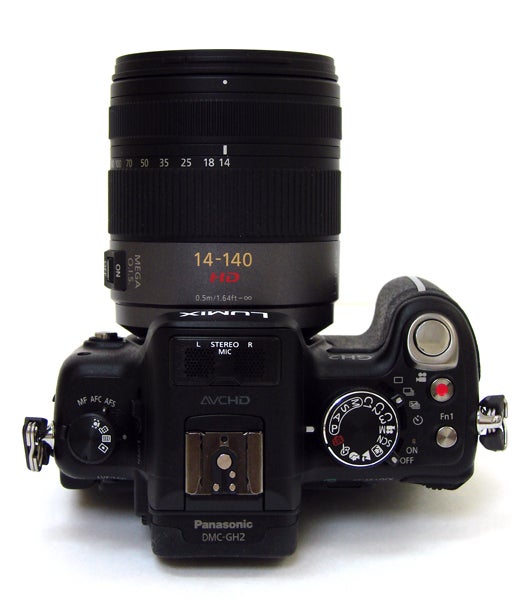
Despite its diminutive dimensions, there are a wealth of manual dials and switches on offer starting with the busy knurled shooting mode dial, which has a stiff feel that means it clunks firmly into place in each of its 14 settings. These include the creative regulars of program, shutter priority, aperture priority and manual exposure modes, along with no fewer than three user-definable settings, portrait, landscape, macro and scene and subject recognising intelligent Auto functionality – the latter for those who really do want to just point and shoot on occasion. The GH2 also offers up the creative ‘My Colour’ mode which offers seven preset effects: Expressive, Retro, Pure, Elegant, Monochrome, Dynamic Art and Silhouette joining Custom mode, the latter letting users set colour, brightness and saturation levels. Best of all these can be previewed before application, with further versatility offered via Panasonic’s regular Film modes, here joined by Cinema mode for the first time as previously indicated.
As on the Canon 60D, we also get a vari-angle LCD screen with 100% field of view – here 3-inches and with a resolution of 460k dots – to allow composition from otherwise awkward angles. The Panasonic’s screen can be angled up and down through 270°, allowing the LCD to be stored facing inwards, or flipped outwards from the body and held alongside it at 180°. With the accent very much on ease of use, this camera ups the ante further by affording a degree of touch screen control too, as first introduced on the Lumix DMC-G2. Scrolling through captured images and settings with a swipe of the finger quickly becomes intuitive. That said, and typically of Panasonic, there are plenty of actual physical controls alongside the screen, including a D-padsolute for if you do find some of the on-screen icons presented to be a little too small and fiddly – as they occasionally are. 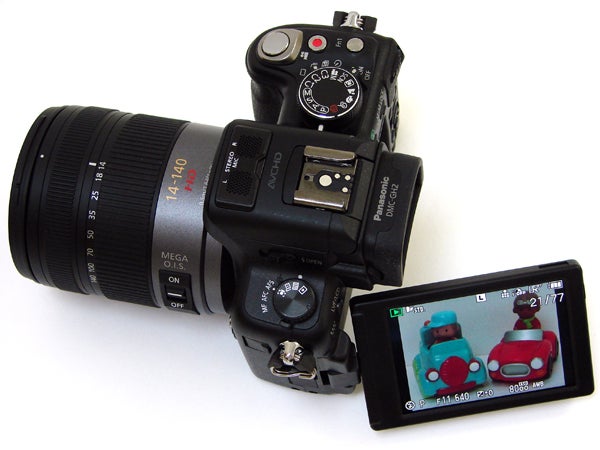
The alternative to using the LCD for shot composition is, of course, using the large and bright electronic viewfinder (EVF) above. This has an impressively high resolution equivalent to 1,530,000 dots. is impressive, and its certainly one of the best EVFs we’ve yet used, but we still do prefer those of the optical variety. Still, at least it provides an easy way to block out the world around you and concentrate on your shot, glare free, unlike most more compact equivalents. As on previous G-series models, an adjacent button lets users swap between LCD and EVF in an instant, whilst there’s a built-in eye sensor as well, which does likewise. This furthers the user friendly feel, putting as few barriers between the photographer and the ability to frame up and take a picture as possible.
As on the GF2, thanks to the camera’s touch panel LCD, users of the GH2 have the ability to fire the shutter or bias focus by simply tapping an intended subject on screen, whilst a touch can also specify a subject for the AF to lock onto and track. Furthermore, touching a face on screen prompts the camera to switch to portrait mode, or to switch to scenery mode if a landscape image is tapped. In effect then, the touch facility is acting as a shortcut rather than a direct replacement for physical controls and dials, which we certainly approve of. As well as dedicated buttons at the rear for adjusting white balance and ISO on the quick, over at the other side of the hump for the built-in flash is a small, barely halfpenny-sized mode wheel for swapping auto focus modes between face detection, AF tracking, the reliable 23-area focusing or 1-area focusing for those who want to get creative. This is encircled by a focus mode lever, offering manual focus, continuous auto focus for taking pictures of moving subjects or single shot AF.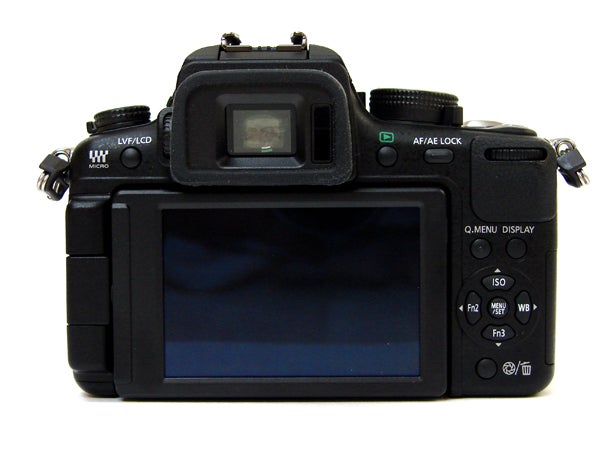
The other selling points here for the GH2 are an auto focus mechanism promised to respond within 0.1 seconds with the 14-140mm lens attached, which Panasonic has grandly termed ‘Light Speed AF’. It’s difficult to put a stop watch to this claim but it’s certainly blink-and-miss it swift, and puts the Live View focus speed of many DSLRs to shame. There’s also the ability to shoot at 5fps at full 16.05 megapixel resolution via High Speed mode – we were able to capture the wing movements of a swan in flight. You can also take a 14 megapixel picture in 16:9 aspect ratio whilst a video clip is being recorded or save a frame as a photo whilst in playback. This camera really is the epitome of versatile.
Flick the on/off switch that encircles the shooting mode wheel, along with a second switch allowing for the swapping of its drive modes, and the GH2 powers up more or less instantaneously. And as mentioned earlier, autofocus is exceptionally fast, while shutter lag is non-existent, and switching to continuous mode gets you 5fps. In singe short mode, full resolution JPEGs are committed to memory in a second, with Raw files barely slower, the bleep to indicate focus and exposure has been determined shrill but reassuringly audible, whilst sound of the shutter release firing is just loud enough to indicate the camera has done its job. In terms of performance this really is a rival to a decent DSLR.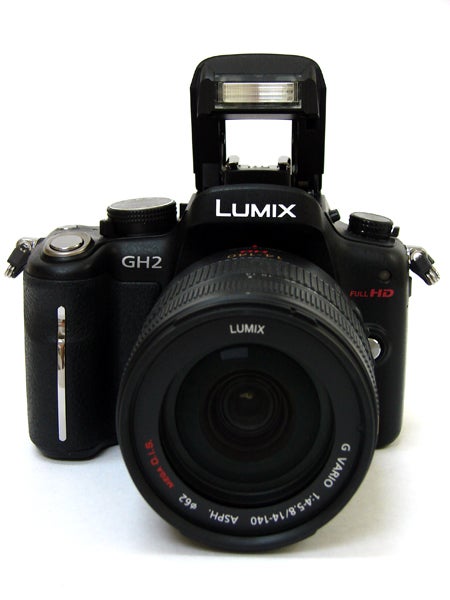
We enjoyed the almost head spinning array of My Color and Film mode options, each of which effects a change to the look and feel of the image. Thankfully, whilst some cameras can over do these effects, the GH2 always seems to result in usable photos.
Video can be captured at up to Full HD (1,920×1,080 pixels) with stereo audio and files stores in the AVCHD format. Alternatively, a slightly lower 1,280×720 pixel option is available in more widely compatible Motion JPEG format. This matches the GF2 as does the inclusion of a wind cut function for shooting outdoors. Plus, as we’ve noted, one press of the provided red button and the user is immediately recording video, black bands cropping the screen top and bottom, no matter which mode might have been previously in play. Thanks to the specially designed lens, adjust your framing whilst filming, and focus will automatically and silently adjust with it.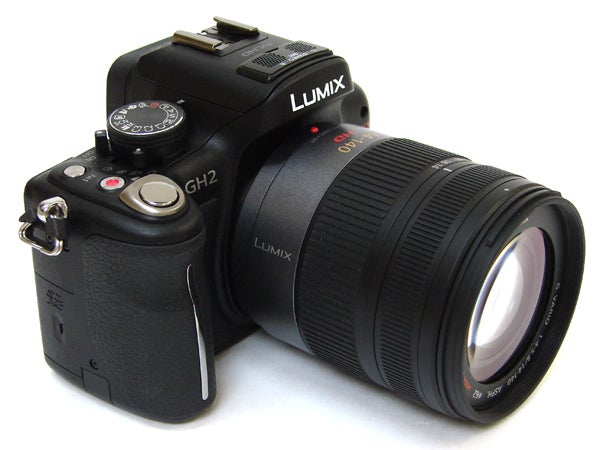
As we’ve found with all Panasonic cameras, colours are naturalistic with a tendency to veer toward the warm side of the spectrum on default settings, which makes the GH2 especially suited to the most popular subjects, such as portraits and landscapes. We got great results with both the 14-140mm and 100-300mm lenses supplied, with the latter our particular favourite for sharpness, clarity and subject definition, though of course the lack of wide angle means it’s not best as your only choice.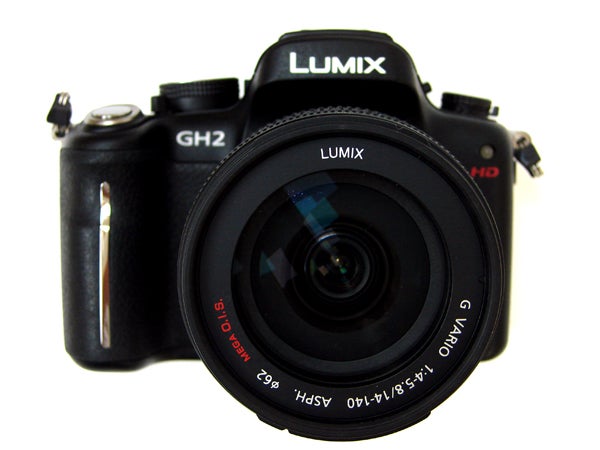
In terms of low light performance, at the lower settings this was pretty much on a par with the GF2, so noise/grain doesn’t really start to become prominent until ISO1600, and even then we’d argue this setting is still usable. However, despite offering an ISO range further expanded up to the rarefied heights of ISO12800, we didn’t find ourselves straying in that direction as image quality becomes noticeably affected. Again, nice to have at a push, but no match for the same settings on Canon and Nikon DSLRs. If it’s competent low light performance you want, the D3100 and D7000 still knock spots off the GH2. It’s as a multi-faceted, general purpose photographic tool then that this Panasonic really comes into its own, and of course there’s always the integral pop up flash and vacant hotshoe at your disposal if extra illumination is required.
”’Verdict”’
The GH2 is an incredibly versatile camera, offering image quality that comes close to a DSLR but in a body that’s lighter and more compact. What’s more, the flip out touchscreen, mass of manual controls, and instant-on video capabilities make it not just a jack but nearly a master of all. However, there is one whopper of a stumbling block, and that’s price. At around £700 for just the body and £1,000 with the versatile 14-140mm lens, it’s put in competition with some very capable DSLRs, such as the Canon 550D that do outstrip it on image quality, performance and lens options. Ultimately, it comes down to which you prioritise; all-in-one ease of use, or a more powerful photographic tool.
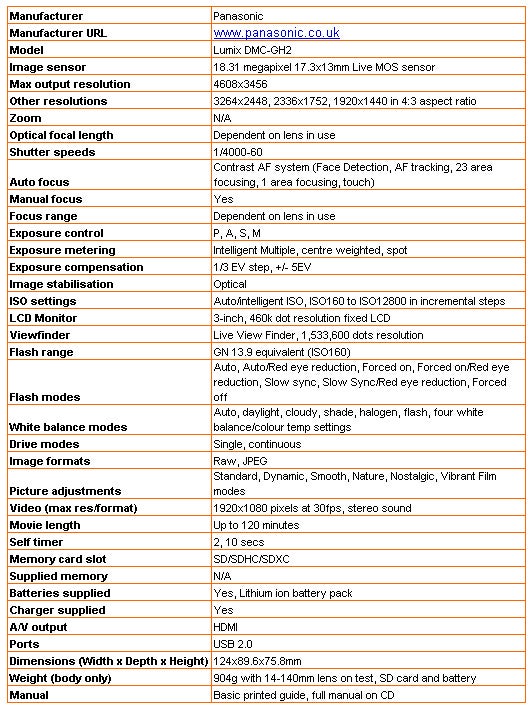
”’The GH2 offers a wide range of manually selectable ISO settings – some 20 incremental choices in all – starting out at ISO160 and finishing at top whack ISO12800 equivalent, with Auto ISO and ‘intelligent’ ISO for those who want to leave the camera to decide, and with commendable consistency as it happens. Rather than bombard you with a myriad ISO examples, we’ve chosen a few choice ones to illustrate the more pronounced changes as we move through the settings.”’
—-

Examining the full frame at ISO160 and all, expectedly, is well with the GH2’s performance
—-

Same crisp and clean subject at ISO400 and similarly no image noise to report.
—-

ISO800 and there’s noise, but again, as we found with the GF2, it’s hardly at a noticeable level.
—-

We’re getting a very mild sandpaper effect at ISO1600, but a very usable image nonetheless.
—-

It’s at ISO3200 that matters start to go noticeably awry, with the image softer in terms of detail, grittier in terms of grain, and with a green-ish colour tint to boot.
—-

Worse again at ISO6400 with a distinctly speckled look to the entire image.
—-

A simply horrible result at maximum ISO12800 equivalent setting, with our ‘photo’ looking more like a cheap and crude photocopy of an image. Certainly no match for the results achievable with mid range DSLRs that offer equivalent ISO expansion settings.
—-
”’A more general selection of test shots are revealed on this page and next to act as an evaluation of the GH2 in a variety of shooting conditions and with different lenses attached, as detailed.”’
—-
An image taken with the optional 100-300mm telephoto zoom at its widest, 200mm equivalent, setting. Good edge to edge sharpness, bags of detail and lush colours straight out of the camera – no complaints here.
—-
And by way of contrast an image taken with the same lens from the same vantage point, but this time at maximum zoom (600mm equivalent in 35mm terms). Handheld too, but still impressively sharp.
—-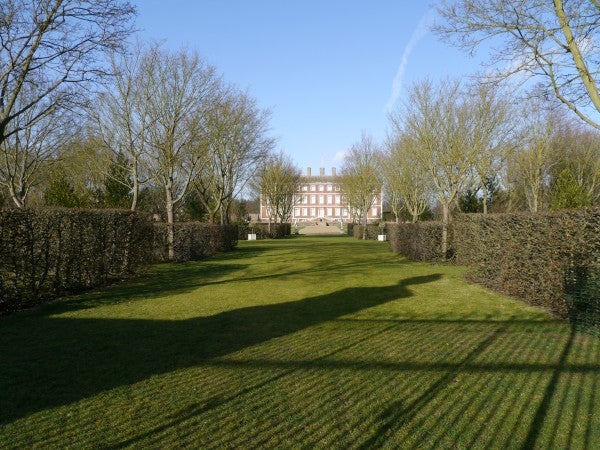
For comparison this shot was taken with the 14-140mm (28-280mm equivalent) lens from the same vantage point, and at maximum wideangle setting. The white balance here appears slightly thrown by the huge expanse of green in the foreground and there’s a slightly washed out appearance.
—-

And the same 14-140mm lens, this time at full zoom, and for us with displaying results much improved. Again handheld and again displaying plenty of detail, particularly visible in the brickwork.
—-
”’Here are some general test shots taken with the GH2 and lenses as stated to give an idea of performance ability when it comes to image quality, dynamic range, colour rendition and the focal range of the respective optics.”’
—-

An image taken with the supplied 14-140mm f/4-5.8 zoom lens handheld at maximum telephoto setting. Bags of detail visible in the duck’s feathers and nice natural colours too.
—-
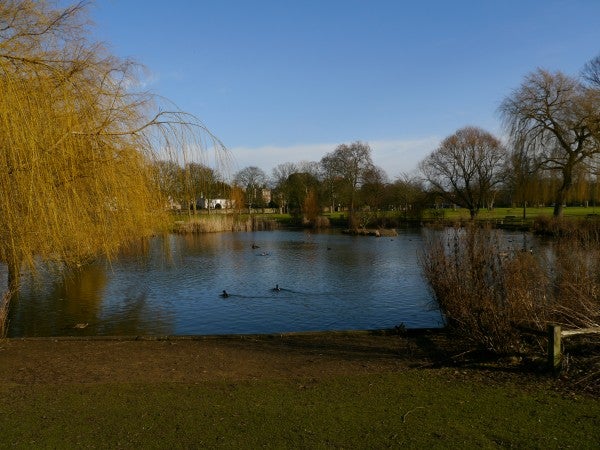
By contrast an extreme wideangle image again taken with the GH2 and 14-140mm f/4-5.8 zoom. Good edge to edge sharpness and any barrel distortion is well hidden if present at all.
—-

An elegant subject, bathed in soft golden sunlight calls for the ‘elegant’ ‘My Color’ mode option. A sympathetic rendition we feel – here also utilising the 100-300mm for some close cropping – and one combination that has worked very well.
—-

Another timeless subject – the white picket fence. Time to try out the GH2’s retro ‘My Color’ mode, the camera equipped with the 100-300mm zoom, for a effectively other-worldly abstract.
—-
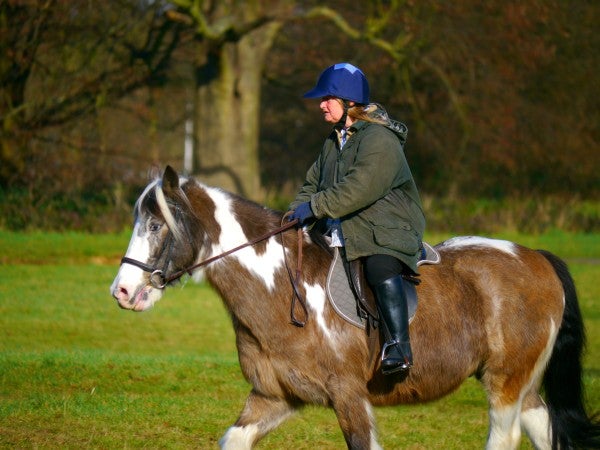
A couple of examples of the richness of colour achievable when selecting the saturation boosting creative option of ‘Expressive’ mode on the GH2. In each case the subject is flattered by the enhancement without it straying too far into the realm of the unnatural.
—-
Trusted Score
Score in detail
-
Value 8
-
Image Quality 9
Features
| Camera type | Micro Four Thirds |
| Megapixels (Megapixel) | 15.9 Megapixel |
| Optical Zoom (Times) | N/Ax |
| Image Sensor | 18.31 megapixel 17.3x13mm Live MOS sensor |
| Optical focal length | Dependent on lens in use |
| Shutter speed | 1/4000-60 |
| Auto focus | Contrast AF system (Face Detection, AF tracking, 23 area focusing, 1 area focusing, touch) |
| Manual focus | Yes |
| Max output resolution | 4608x3456 |
| Other resolutions | 3264x2248, 2336x1752, 1920x1440 in 4:3 aspect ratio |
| Focus range | Dependent on lens in use |
| Exposure control | P, A, S, M |
| Exposure metering | Intelligent Multiple, centre weighted, spot |
| Exposure compensation | 1/3 EV step, +/- 5EV |
| Image Stabilisation | Optical |
| ISO settings | Auto/intelligent ISO, ISO160 to ISO12800 in incremental steps |
| LCD Monitor | 3-inch, 460k dot resolution fixed LCD |
| Viewfinder | Live View Finder, 1,533,600 dots resolution |
| Flash range | GN 13.9 equivalent (ISO160) |
| Flash modes | Auto, Auto/Red eye reduction, Forced on, Forced on/Red eye reduction, Slow sync, Slow Sync/Red eye reduction, Forced off |
| White balance modes | Auto, daylight, cloudy, shade, halogen, flash, four white balance/colour temp settings |
| Drive modes | Single, continuous |
| Image formats | Raw, JPEG |
| Picture adjustments | Standard, Dynamic, Smooth, Nature, Nostalgic, Vibrant Film modes |
| Video (max res/format) | 1920x1080 pixels at 30fps, stereo sound |
| Movie length | Up to 120 minutes |
| Self timer | 2, 10 secs |
| Memory card slot | SD/SDHC/SDXC |
| Supplied memory | N/A |
| Batteries supplied | Yes, lithium ion pack |
| Charger supplied | Yes |
| A/V output | HDMI |
| Charging/Computer Connection | USB 2.0 |
| HDMI | Yes |
| AV Out | Yes |
| Manual | Basic printed guide, full manual on CD |
Physical Specifications
| Dimensions Width (Millimeter) | 124mm |
| Depth (Millimeter) | 89.6mm |
| Weight (body only) (Kilogram) | 904g with 14-140mm lens on test, SD card and batterykg |

